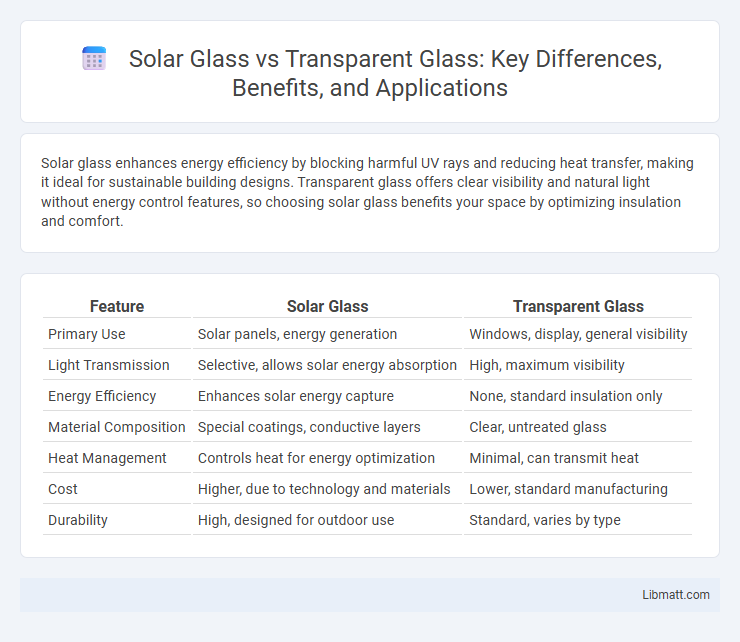Solar glass enhances energy efficiency by blocking harmful UV rays and reducing heat transfer, making it ideal for sustainable building designs. Transparent glass offers clear visibility and natural light without energy control features, so choosing solar glass benefits your space by optimizing insulation and comfort.
Table of Comparison
| Feature | Solar Glass | Transparent Glass |
|---|---|---|
| Primary Use | Solar panels, energy generation | Windows, display, general visibility |
| Light Transmission | Selective, allows solar energy absorption | High, maximum visibility |
| Energy Efficiency | Enhances solar energy capture | None, standard insulation only |
| Material Composition | Special coatings, conductive layers | Clear, untreated glass |
| Heat Management | Controls heat for energy optimization | Minimal, can transmit heat |
| Cost | Higher, due to technology and materials | Lower, standard manufacturing |
| Durability | High, designed for outdoor use | Standard, varies by type |
Introduction to Solar Glass and Transparent Glass
Solar glass, engineered with photovoltaic coatings, captures sunlight to generate renewable energy while maintaining transparency. Transparent glass, commonly used in windows and building facades, offers clear visibility without the energy-converting properties of solar glass. Your choice between these materials impacts energy efficiency and natural light utilization in architectural designs.
How Solar Glass Works
Solar glass incorporates photovoltaic cells that convert sunlight into electrical energy by absorbing solar radiation, unlike transparent glass which primarily serves as a clear barrier without energy-harvesting capabilities. The specialized coatings and materials in solar glass enhance light absorption and reduce reflection, improving overall solar efficiency. This technology enables buildings and devices to generate renewable energy while maintaining natural light transmission.
Properties of Transparent Glass
Transparent glass offers high clarity and excellent light transmission, allowing up to 90% or more of visible light to pass through, making it ideal for windows and displays. Its properties include low iron content for better color neutrality, good thermal insulation with tempered or laminated options, and durability against weather and impacts. If your project requires maximum visibility and natural light, transparent glass ensures clear vision and aesthetic appeal without significantly altering the view.
Energy Efficiency Comparison
Solar glass outperforms transparent glass in energy efficiency by significantly reducing heat transfer and enhancing insulation, which lowers cooling and heating costs. Transparent glass allows more solar heat to pass through, leading to higher energy consumption in climate control systems. Choosing solar glass for your windows optimizes energy savings by effectively blocking ultraviolet and infrared rays while maintaining natural light.
Light Transmission and Aesthetics
Solar glass typically transmits less light than transparent glass, filtering harmful UV rays and reducing glare while maintaining energy efficiency. Transparent glass offers higher light transmission, allowing more natural sunlight and clearer views but lacks built-in solar control properties. Your choice depends on whether maximizing daylight or enhancing energy savings and glare reduction aligns with your aesthetic and functional needs.
Cost Differences and ROI
Solar glass generally has a higher upfront cost compared to transparent glass due to integrated photovoltaic technology that generates electricity. Despite initial expenses, solar glass offers a faster return on investment (ROI) by reducing energy bills and enabling potential revenue through energy credits or sales. Transparent glass lacks energy-generating capabilities, resulting in lower initial costs but no direct energy savings or financial returns over time.
Durability and Lifespan
Solar glass typically exhibits higher durability and a longer lifespan due to its specialized coatings that protect against UV radiation and environmental wear. Transparent glass, while often less expensive, tends to be more susceptible to scratches, weathering, and degradation over time. Enhanced resistance to thermal stress and impact damage in solar glass makes it a preferred choice for long-term energy solutions.
Environmental Impact
Solar glass significantly reduces environmental impact by enhancing energy efficiency through its ability to harvest solar energy, lowering reliance on fossil fuels and reducing greenhouse gas emissions. Transparent glass, while offering natural light benefits, lacks energy generation capabilities and can contribute to higher cooling demands, increasing energy consumption. Choosing solar glass for your building projects supports sustainable practices and helps minimize your carbon footprint.
Practical Applications in Architecture
Solar glass integrates photovoltaic cells to convert sunlight into energy, making it ideal for sustainable building designs such as skylights, facades, and windows that contribute to energy efficiency. Transparent glass is preferred for maximizing natural light and maintaining clear views in residential and commercial buildings but lacks energy-generating capabilities. Hybrid architectural solutions often combine solar glass for energy production with transparent glass to balance aesthetics and functionality in modern construction.
Choosing Between Solar Glass and Transparent Glass
Choosing between solar glass and transparent glass depends on your energy efficiency goals and aesthetic preferences. Solar glass integrates photovoltaic cells to generate electricity while allowing natural light, optimizing energy savings without sacrificing visibility. Transparent glass offers clear views and natural lighting but lacks the energy-harvesting benefits that solar glass provides.
solar glass vs transparent glass Infographic

 libmatt.com
libmatt.com